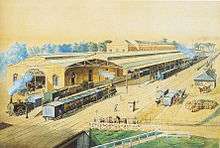Dutch Rhenish Railway
 The Dutch Rhenish Railway station at Utrecht in 1866 | |
| Formation | 1845 |
|---|---|
| Extinction | 1890 |
| Type | privately owned railway company |
| Location |
|
The Dutch Rhenish Railway or Dutch–Rhenish Railway (Dutch: Nederlandsche Rhijnspoorweg or Nederlandsche Rhijn-Spoorweg) was a Dutch railway company active from 1845 until 1890.
History
The Dutch Rhenish Railway Company Limited was founded in Amsterdam on 3 July 1845[1] to take over the State-run Rhenish Railway, which was losing money. The majority of the shareholders were English.[2] In or shortly after 1857 James Staats Forbes was appointed general manager for five years. He remained a permanent adviser to the company until its concession expired and it was nationalised in 1890.[3]
Locomotive number 107, Sharp Stewart 3563/1889, is preserved in the Utrecht Railway Museum.[4]
Lines
Lines built and operated by the Dutch Rhenish Railway include:
- The Utrecht – Rotterdam line, opened in 1855[5]
- The extension of the Rhenish Railway to Germany, opened in 1856
- The Zevenaar – Cleves line, opened in 1865
- The Harmelen – Breukelen line, opened in 1869
- The Gouda – The Hague line, opened in 1870.
References
- ↑ Frederick J. Teggart (1895). Catalogue of the Hopkins Railway Library. Palo Alto, CA: Leland Stanford Junior University. p. 132.
- ↑ Augustus J. Veenendaal, Jr. (1995). State versus Private Enterprise in Railway Building in the Netherlands, 1838-1938. Business and Economic History 24 (1): 186–193. Accessed September 2013.
- ↑ Charles Welch (2004). Forbes, James Staats (1823–1904). Oxford Dictionary of National Biography. Oxford University Press. doi:10.1093/ref:odnb/33192.
- ↑ James Waite ([n.d.]). Narrow Gauge Steam Railways in Holland. The International Steam Pages. Accessed September 2013.
- ↑ [s.n.] (1 January 1855). The opening of the Dutch Rhenish railway at a temporary station in Rotterdam. Illustrated London News. Accessed September 2013.
This article is issued from Wikipedia - version of the 8/23/2016. The text is available under the Creative Commons Attribution/Share Alike but additional terms may apply for the media files.